
Aleuria aurantia is a widespread ascomycete fungus in the order Pezizales. The brilliant orange, cup-shaped ascocarps often resemble orange peels strewn on the ground, giving this species its common name.
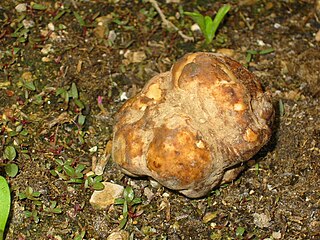
Terfezia is a genus of truffle-like fungi within the Pezizaceae family. Terfezia species are commonly known as desert truffles. Some authorities consider this the type genus of the family Terfeziaceae, although phylogenetic analysis suggests that it nests within the Pezizaceae. The Dictionary of the Fungi suggests that the genus contains 12 species. A recent (2011) publication used molecular analysis to show that the American Terfezia species had been incorrectly classified, and moved Terfezia spinosa and Terfezia longii to Mattirolomyces and Stouffera, respectively; as a result, no Terfezia species are known to exist in North America.
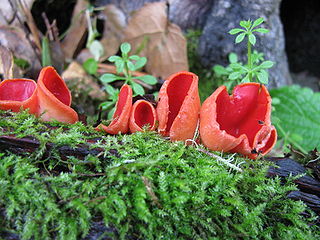
Sarcoscypha coccinea, commonly known as the scarlet elf cup, scarlet elf cap, or the scarlet cup, is a species of fungus in the family Sarcoscyphaceae of the order Pezizales. The fungus, widely distributed in the Northern Hemisphere, has been found in Africa, Asia, Europe, North and South America, and Australia. The type species of the genus Sarcoscypha, S. coccinea has been known by many names since its first appearance in the scientific literature in 1772. Phylogenetic analysis shows the species to be most closely related to other Sarcoscypha species that contain numerous small oil droplets in their spores, such as the North Atlantic island species S. macaronesica. Due to similar physical appearances and sometimes overlapping distributions, S. coccinea has often been confused with S. occidentalis, S. austriaca, and S. dudleyi.
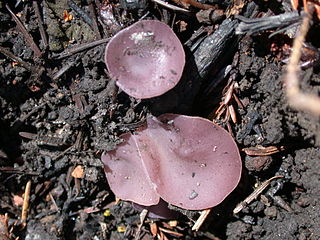
Peziza violacea, commonly known as the violet fairy cup or the violet cup fungus, is a species of fungus in the genus Peziza of the family Pezizaceae. As both it common names and specific epithet suggest, the cup-shaped fruiting bodies are violet colored on the interior surface. P. violacea is typically found growing on burnt soil.

Geopyxis carbonaria is a species of fungus in the genus Geopyxis, family Pyronemataceae. First described to science in 1805, and given its current name in 1889, the species is commonly known as the charcoal loving elf-cup, dwarf acorn cup, stalked bonfire cup, or pixie cup. The small, goblet-shaped fruitbodies of the fungus are reddish-brown with a whitish fringe and measure up to 2 cm across. They have a short, tapered stalk. Fruitbodies are commonly found on soil where brush has recently been burned, sometimes in great numbers. The fungus is distributed throughout many temperate regions of the Northern Hemisphere. It is found in Europe, Turkey, and North America. Although it is primarily a saprotrophic species, feeding on the decomposing organic matter remaining after a fire, it also forms biotrophic associations with the roots of Norway spruce.

Scutellinia scutellata, commonly known as the eyelash cup, the Molly eye-winker, the scarlet elf cap, the eyelash fungus or the eyelash pixie cup, is a small saprophytic fungus of the genus Scutellinia. It is the type species of Scutellinia, as well as being the most common and widespread. The fruiting bodies are small red cups with distinct long, dark hairs or "eyelashes". These eyelashes are the most distinctive feature and are easily visible with a magnifying glass. The species is common in North America and Europe, and has been recorded on every continent. S. scutellata is found on rotting wood and in other damp habitats, typically growing in small groups, sometimes forming clusters. It is sometimes described as inedible, but its small size means it is not suitable for culinary use. Despite this, it is popular among mushroom hunters due to its unusual "eyelash" hairs, making it memorable and easy to identify.

Helvella acetabulum is a species of fungus in the family Helvellaceae, order Pezizales. This relatively large cup-shaped fungus is characterized by a tan fruit body with prominent branching ribs resembling a cabbage leaf; for this reason it is commonly known as the cabbage leaf Helvella. Other colloquial names include the vinegar cup and the brown ribbed elfin cup. The fruit bodies reaches dimensions of 8 cm (3.1 in) by 4 cm (1.6 in) tall. It is found in Asia, Europe, and North America, where it grows in sandy soils, under both coniferous and deciduous trees.

Sarcosphaera is a fungal genus within the Pezizaceae family. It is a monotypic genus, containing the single species Sarcosphaera coronaria, commonly known as the pink crown, the violet crown-cup, or the violet star cup. It is a whitish or grayish cup fungus, distinguished by the manner in which the cup splits into lobes from the top downward. It is commonly found in the mountains in coniferous woods under humus on the forest floor, and often appears after the snow melts in late spring and early summer. The fungus is widespread, and has been collected in Europe, Israel and the Asian part of Turkey, North Africa, and North America. In Europe, it is considered a threatened species in 14 countries. Although several taxa have been described as Sarcosphaera species since the introduction of the genus in 1869, most lack modern descriptions, have been transferred to the related genus Peziza, or are considered synonymous with S. coronaria.

Amanita flavoconia, commonly known as yellow patches, yellow wart, orange amanita, yellow-dust amanita or the American yellow dust amanita, is a species of mushroom in the family Amanitaceae. It has an orangish-yellow cap with yellowish-orange patches or warts, a yellowish-orange annulus, and a white to orange stem. Common and widespread throughout eastern North America, Amanita flavoconia grows on the ground in broad-leaved and mixed forests, especially in mycorrhizal association with hemlock.
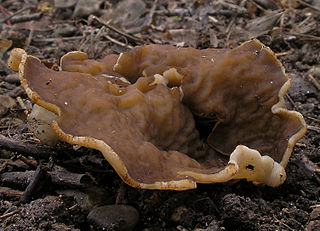
Disciotis venosa, commonly known as the bleach cup, veiny cup fungus, or the cup morel is a species of fungus in the family Morchellaceae. Fruiting in April and May, they are often difficult to locate because of their nondescript brown color. Found in North America and Europe, they appear to favor banks and slopes and sheltered sites. Although D. venosa is considered edible, it may resemble several other species of brown cup fungi of unknown edibility.
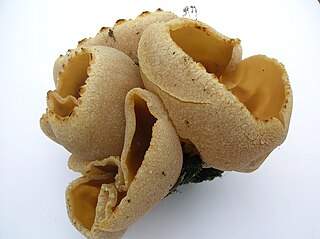
Peziza cerea, commonly known as the Cellar Cup is a species of ascomycete fungus in the genus Peziza, family Pezizaceae. In common with other ascomycetes the upper surface of the fungus has a layer of cylindrical spore producing cells called asci, from which the ascospores are forcibly discharged.

Mycena aurantiomarginata, commonly known as the golden-edge bonnet, is a species of agaric fungus in the family Mycenaceae. First formally described in 1803, it was given its current name in 1872. Widely distributed, it is common in Europe and North America, and has also been collected in North Africa, Central America, and Japan. The fungus is saprobic, and produces fruit bodies (mushrooms) that grow on the floor of coniferous forests. The mushrooms have a bell-shaped to conical cap up to 2 cm in diameter, set atop a slender stipe up to 6 cm long with yellow to orange hairs at the base. The fungus is named after its characteristic bright orange gill edges. A microscopic characteristic is the club-shaped cystidia that are covered with numerous spiky projections, resembling a mace. The edibility of the mushroom has not been determined. M. aurantiomarginata can be distinguished from similar Mycena species by differences in size, color, and substrate. A 2010 publication reported the discovery and characterization of a novel pigment named mycenaaurin A, isolated from the mushroom. The pigment is responsible for its color, and it has antibiotic activity that may function to prevent certain bacteria from growing on the mushroom.

Galiella rufa, commonly known as the rubber cup, the rufous rubber cup, or the hairy rubber cup, is a species of fungus in the family Sarcosomataceae. The fungus produces cup-shaped fruit bodies that typically grow in clusters on branches and exposed portions of buried wood throughout eastern and Midwest North America and in Malaysia. The fruit bodies have the texture of tough, gelatinous rubber, and have a rough, blackish-brown, felt-like outer surface and a smooth reddish-brown inner surface. Although generally considered inedible by North American mushroom field guides, it is commonly consumed in Malaysia. The fungus produces several interesting natural products.

Kalapuya brunnea is a species of truffle in the monotypic fungal genus Kalapuya. The truffle occurs only in the Pacific Northwest region of the United States, in western Oregon and northern California. Known locally as the Oregon brown truffle, it was formerly thought to be an undescribed species of Leucangium until molecular analysis demonstrated that it was distinct from that genus. The truffle is reddish brown with a rough and warty outer skin, while the interior spore-producing gleba is initially whitish before developing greyish-brown mottling as it matures. Mature truffles have an odor resembling garlicky cheese, similar to mature Camembert. The species has been harvested for culinary purposes in Oregon.
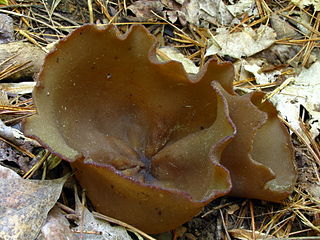
Peziza phyllogena, commonly known as the common brown cup or the pig-ear cup, is a species of fungus in the family Pezizaceae. A saprobic species, the fungus produces brownish, cup-shaped fruit bodies that grow singly or in clusters on either soil or well-rotted wood. It is found in Europe, North America, and Iceland, where it fruits in the spring.

Peziza succosa is a species of apothecial fungus belonging to the family Pezizaceae. It grows in woods in Europe, Iceland, Israel, China, Argentina, and the United States. In Europe this fungus appears in summer and autumn as grey or brown saucers up to 10 cm (3.9 in) in diameter on soil in woodland, often at pathsides. In the United States, this type of cup fungi may also be found on decaying deciduous wood. It is inedible.

Peziza varia, commonly known as the Palomino cup or recurved cup, is a species of fungus in the genus Peziza, family Pezizaceae.
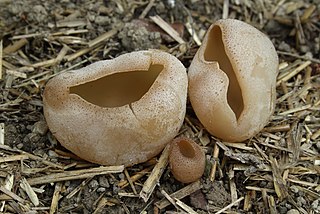
Peziza vesiculosa is a species of apothecial fungus belonging to the family Pezizaceae. This is a common species of Europe, with scattered records in other parts of the world. The pale, cup-shaped ascocarps can grow quite large and often form densely packed groups. It is found on nutrient-rich soils, rotting straw and manure and can often be seen on compost heaps. The species is considered poisonous.

Plicaria endocarpoides is a species of apothecial fungus belonging to the family Pezizaceae. This is a common European fungus of burnt ground, appearing from spring to autumn as dark brownish-coloured cups up to 6 cm in diameter, usually in groups. The caps usually flatten with age.

Peziza fimeti is a species of ascomycete fungus belonging to the family Pezizaceae. Found in Europe and North America, the fungus grows on cow dung. It produces small, light brown, cup-shaped fruit bodies up to 2 cm (0.8 in) in diameter. The asci are cylindrical, with dimensions of up to 280 µm long and 18 µm in diameter. The spores are ellipsoid and measure 8 by 16 µm.




















